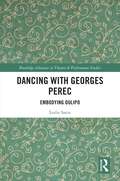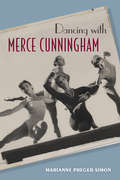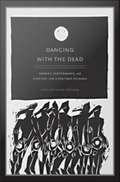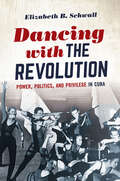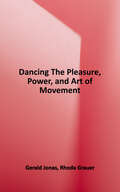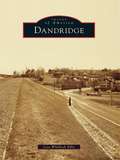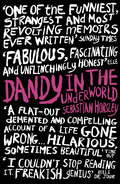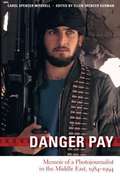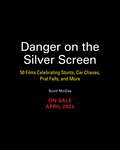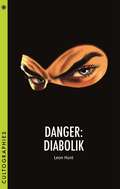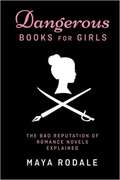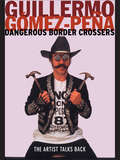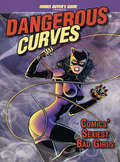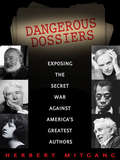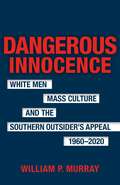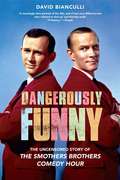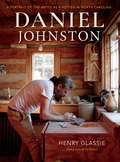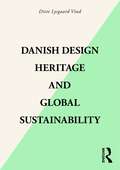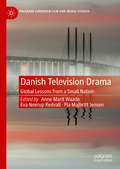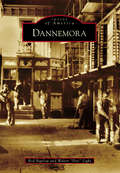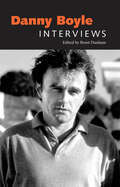- Table View
- List View
Dancing with Georges Perec: Embodying Oulipo (ISSN)
by Leslie SatinThis book explores the relationship of the life and work of the remarkable Parisian-Jewish writer Georges Perec (1936–1983) to dance."Dancing" addresses art-making parallels and their personal and sociocultural contexts, including Perec’s childhood loss of his parents in the Holocaust and its repercussions in the significance of the body, everydayness, space, and attention permeating his work. This book, emerging from the author Leslie Satin’s perspective as a dancer and scholar, links Perec’s concerns with those of dance and demonstrates that Perec’s work has implications for dance and how we think about it. Moreover, it is framed as a performative autobiographical enactment of the author's relationship to Perec, periodically linking their written, danced, and imagined lives.This exploration will be of great interest to dancers, dance scholars, and dance students interested in contemporary experimental dance and contemporary dance.
Dancing with Merce Cunningham
by Marianne Preger-SimonDancing with Merce Cunningham is a buoyant, captivating memoir of a talented dancer’s lifelong friendship with one of the choreographic geniuses of our time. Dancing with Merce Cunningham is a buoyant, captivating memoir of a talented dancer’s lifelong friendship with one of the choreographic geniuses of our time. Marianne Preger-Simon’s story opens amid the explosion of artistic creativity that followed World War II. While immersed in the vibrant arts scene of postwar Paris during a college year abroad, Preger-Simon was so struck by Merce Cunningham’s unconventional dance style that she joined his classes in New York. She soon became an important member of his brand new dance troupe—and a constant friend. Through her experiences in the Merce Cunningham Dance Company, Preger-Simon offers a rare account of exactly how Cunningham taught and interacted with his students. She describes the puzzled reactions of audiences to the novel non-narrative choreography of the company’s debut performances. She touches on Cunningham’s quicksilver temperament—lamenting his early frustrations with obscurity and the discomfort she suspects he endured in concealing his homosexuality and partnership with composer John Cage—yet she celebrates above all his dependable charm, kindness, and engagement. She also portrays the comradery among the company’s dancers, designers, and musicians, many of whom—including Cage, David Tudor, and Carolyn Brown—would become integral to the avant-garde arts movement, as she tells tales of their adventures touring in a VW Microbus across the United States. Finally, reflecting on her connection with Cunningham throughout the latter part of his career, Preger-Simon recalls warm moments that nurtured their enduring bond after she left the dance company and, later, New York. Interspersed with her letters to friends and family, journal entries, and correspondence from Cunningham himself, Preger-Simon’s memoir is an intimate look at one of the most influential companies in modern American dance and the brilliance of its visionary leader.
Dancing with the Dead: Memory, Performance, and Everyday Life in Postwar Okinawa
by Christopher NelsonChallenging conventional understandings of time and memory, Christopher T. Nelson examines how contemporary Okinawans have contested, appropriated, and transformed the burdens and possibilities of the past. Nelson explores the work of a circle of Okinawan storytellers, ethnographers, musicians, and dancers deeply engaged with the legacies of a brutal Japanese colonial era, the almost unimaginable devastation of the Pacific War, and a long American military occupation that still casts its shadow over the islands. The ethnographic research that Nelson conducted in Okinawa in the late 1990s--and his broader effort to understand Okinawans' critical and creative struggles--was inspired by his first visit to the islands in 1985 as a lieutenant in the U. S. Marine Corps. Nelson analyzes the practices of specific performers, showing how memories are recalled, bodies remade, and actions rethought as Okinawans work through fragments of the past in order to reconstruct the fabric of everyday life. Artists such as the popular Okinawan actor and storyteller Fujiki Hayato weave together genres including Japanese stand-up comedy, Okinawan celebratory rituals, and ethnographic studies of war memory, encouraging their audiences to imagine other ways to live in the modern world. Nelson looks at the efforts of performers and activists to wrest the Okinawan past from romantic representations of idyllic rural life in the Japanese media and reactionary appropriations of traditional values by conservative politicians. In his consideration of eisā, the traditional dance for the dead, Nelson finds a practice that reaches beyond the expected boundaries of mourning and commemoration, as the living and the dead come together to create a moment in which a new world might be built from the ruins of the old.
Dancing with the Revolution: Power, Politics, and Privilege in Cuba (Envisioning Cuba)
by Elizabeth B. SchwallElizabeth B. Schwall aligns culture and politics by focusing on an art form that became a darling of the Cuban revolution: dance. In this history of staged performance in ballet, modern dance, and folkloric dance, Schwall analyzes how and why dance artists interacted with republican and, later, revolutionary politics. Drawing on written and visual archives, including intriguing exchanges between dancers and bureaucrats, Schwall argues that Cuban dancers used their bodies and ephemeral, nonverbal choreography to support and critique political regimes and cultural biases.As esteemed artists, Cuban dancers exercised considerable power and influence. They often used their art to posit more radical notions of social justice than political leaders were able or willing to implement. After 1959, while generally promoting revolutionary projects like mass education and internationalist solidarity, they also took risks by challenging racial prejudice, gender norms, and censorship, all of which could affect dancers personally. On a broader level, Schwall shows that dance, too often overlooked in histories of Latin America and the Caribbean, provides fresh perspectives on what it means for people, and nations, to move through the world.
Dancing: The Pleasure, Power, and Art of Movement
by Gerald JonasLooks at the history of dance, dance around the world, and influential dancers and choreographers of the past and present.
Dandridge (Images of America)
by Lisa Whillock EllisDandridge, Tennessee, the second-oldest town in the state, was founded in 1783 by a group of Scotch-Irish settlers. It was 13 years before Tennessee became the 16th state. The town began as a small frontier settlement along the banks of the French Broad River in the short-lived state of Franklin. In 1793, Dandridge became the county seat for the newly formed Jefferson County. The county was named for then U.S. secretary of state Thomas Jefferson. Dandridge is the only town in the United States named for first lady Martha Dandridge Custis Washington. Davy Crockett married his first wife near Dandridge, and the courthouse still has his marriage bond in its archives. Over the years, it has played host to presidents Andrew Jackson, James K. Polk, and Andrew Johnson. During the Civil War, the Battle of Dandridge was fought there in winter 1864. In 1942, the town was saved when the Tennessee Valley Authority built a dike to protect it from the waters of Douglas Lake.
Dandy in the Underworld: A Memoir
by Sebastian Horsley'Like Salvador Dali's confessions, only far funnier and more self-deprecating, Dandy in the Underworld entertains as much as it revolts, is as tender as it is shocking, and as genuine as it is false.' IndependentSure to shock and surprise, Sebastian Horsley recounts his life story with excruciating self-knowledge and a savage wit.'One of the funniest, strangest and most revolting memoirs ever written.' Sunday TimesGrowing up at High Hall, in Hull, with his alcoholic mother, who regularly attempted suicide, his stepfather, a cult member dressed in orange, and his father, a crippled millionaire, Sebastian Horsley couldn't wait to leave home. Searching for happiness, meaning and a good outfit he embarked on a doomed career as a punk guitarist, had a stormy relationship with a notorious Scottish gangster, enjoyed a wildly successful period as a stock-market entrepeneur and experienced a near fatal stint as a shark-hunter. Sebastian charts his years as a dandy, an artist, a male escort and a brothel connoisseur. There are the love affairs, with Rachel 1 and Rachel 2, and a harrowing descent into heroin and crack addiction. Dandy in the Underworld evokes his desperate attempts to get clean, culminating in his crucifixion in the Philippines.
Dandy in the Underworld: A Memoir (P. S. Ser.)
by Sebastian Horsley'Like Salvador Dali's confessions, only far funnier and more self-deprecating, Dandy in the Underworld entertains as much as it revolts, is as tender as it is shocking, and as genuine as it is false.' IndependentSure to shock and surprise, Sebastian Horsley recounts his life story with excruciating self-knowledge and a savage wit.'One of the funniest, strangest and most revolting memoirs ever written.' Sunday TimesGrowing up at High Hall, in Hull, with his alcoholic mother, who regularly attempted suicide, his stepfather, a cult member dressed in orange, and his father, a crippled millionaire, Sebastian Horsley couldn't wait to leave home. Searching for happiness, meaning and a good outfit he embarked on a doomed career as a punk guitarist, had a stormy relationship with a notorious Scottish gangster, enjoyed a wildly successful period as a stock-market entrepeneur and experienced a near fatal stint as a shark-hunter. Sebastian charts his years as a dandy, an artist, a male escort and a brothel connoisseur. There are the love affairs, with Rachel 1 and Rachel 2, and a harrowing descent into heroin and crack addiction. Dandy in the Underworld evokes his desperate attempts to get clean, culminating in his crucifixion in the Philippines.
Danger Pay
by Carol Spencer Mitchell"You're going where?" Carol Spencer Mitchell's father demanded as she set off in 1984 to cover the Middle East as a photojournalist for Newsweek and other publications. In this intensely thoughtful memoir, Spencer Mitchell probes the motivations that impelled her, a single, Jewish woman, to document the turmoil roiling the Arab world in the 1980s and 1990s, as well as how her experiences as a photojournalist "compelled [me] to set aside [my] cameras and reexamine the way images are created, scenes are framed, and how 'real life' is packaged for specific news stories. " In Danger Pay, Spencer Mitchell takes us on a harrowing journey to PLO military training camps for Palestinian children and to refugee camps in the Gaza Strip before, during, and after the first intifada. Through her eyes, we experience the media frenzy surrounding the 1985 hijackings of TWA Flight #847 and the Italian cruise liner Achille Lauro. We meet Middle Eastern leaders, in particular Yasser Arafat and King Hussein of Jordan, with whom Spencer Mitchell developed close working relationships. And we witness Spencer Mitchell's growing conviction that the Western media's portrayal of conflicts in the Middle East actually helps to fuel those conflicts-a conviction that eventually, as she says, "shattered my career. " Although the events that Spencer Mitchell records took place a generation ago, their repercussions reverberate in the conflicts going on in the Middle East today. Likewise, her concern about "the triumph of image over reality" takes on greater urgency as our knowledge of the world becomes ever more filtered by virtual media.
Danger on the Silver Screen: 50 Films Celebrating Cinema's Greatest Stunts (Turner Classic Movies)
by Scott McGeeTurner Classic Movies presents a heart-racing look into the world of stunt work featuring films that capture the exhilaration of a car chase, the comedy of a well timed prat fall, or the adrenaline rush from a fight scene complete with reviews, behind-the-scenes stories, and hundreds of photographs.Buckle in and join TCM on a action-packed journey through the history of cinema stunt work in Danger on the Silver Screen. This action-packed guide profiles 50 foundational films with insightful commentary on the history, importance, and evolution of an often overlooked element of film: stunt work. With insightful commentary and additional recommendations to expand your repertoire based on your favorites, Danger on the Silver Screen is a one-of-a-kind guide, perfect for film lovers to learn more about or just brush up on their knowledge of stunt work and includes films such as Ben-Hur (1925 & 1959), The Great K&A Train Robbery (1926), Steamboat Bill Jr. (1928), The Thing from Another World (1951), Bullitt (1968), Live and Let Die (1973), The Blues Brothers (1980), Romancing the Stone (1984), The Matrix (1999), The Bourne Supremacy (2004), John Wick (2014), Mission: Impossible—Rogue Nation (2015), Atomic Blonde (2017), and many more.
Danger: Diabolik (Cultographies)
by Leon HuntDanger: Diabolik (1968) was adapted from a comic that has been a social phenomenon in Italy for over fifty years, featuring a masked master criminal—part Fantômas, part James Bond—and his elegant companion Eva Kant. The film partially reinvents the character as a countercultural prankster, subverting public officials and the national economy, and places him in a luxurious and futuristic underground hideout and Eva in a series of unforgettable outfits. A commercial disappointment on its original release, Danger: Diabolik's reputation has grown along with that of its director, Mario Bava, the quintessential cult auteur, while the pop-art glamour of its costumes and sets have caught the imagination of such people as Roman Coppola and the Beastie Boys.This study examines its status as a comic-book movie, including its relation both to the original fumetto and to its sister-film, Barbarella. It traces its production and initial reception in Italy, France, the U.S., and the UK, and its cult afterlife as both a pop-art classic and campy "bad film" featured in the final episode of Mystery Science Theatre 3000.
Dangerous Bodies: New Global Perspectives on Fashion and Transgression (Palgrave Studies in Fashion and the Body)
by Jacki Willson Royce MahawatteThis edited book brings together new perspectives on fashion, the body, and politics. The intention of this collection is to explore the cultural intersection between bodies, fashion, and transgression, often in the most unlikely of locations. Bodies are political players in culture and the authors gathered here ask a range of pressing questions. What role do fashioned bodies play in resistance, in meeting governmental boundaries or institutional power? Arguably, fashion is an aspect of modern warfare and style can defend and attack in cultural space. So, how do fashioned bodies occupy the grey area between social control and the resistance to power? This book is interdisciplinary and international, with contributors situated within a broad range of disciplines including Art History and Critical Practice, Cultural Studies, Fashion Critical Studies, Film and Literary Studies, Performance Studies, Politics and International Studies, Sociology, Gender, Queer, LGBTI, and Critical Race Studies.
Dangerous Books for Girls
by Maya RodaleLong before clinch covers and bodice rippers, romance novels had a bad reputation as the lowbrow lit of desperate housewives and hopeless spinsters. But why were these books—the escape and entertainment of choice for millions of women—singled out for scorn and shame? Dangerous Books for Girls examines the secret history of the genre’s bad reputation—from the “damned mob of scribbling women” in the nineteenth century to the sexy mass-market paperbacks of the twentieth century—and shows how romance novels have inspired and empowered generations of women to dream big, refuse to settle, and believe they’re worth it. <P><P>For every woman who has ever hidden the cover of a romance—and every woman who has been curious about those “Fabio books”—Dangerous Books For Girls shows why there’s no room for guilt when reading for pleasure.
Dangerous Border Crossers
by Guillermo Gomez-PenaThis anthology of Gómez-Peña's performance chronicles, diary entries, poems, essays, and texts, sheds an extraordinary light on the life and work of this migrant provocateur.
Dangerous Curves: Comics' Sexiest Bad Girls (CBG Presents)
by Brent FrankenhoffThe oh-so-sexy but oh-so-dangerous dames of the comic book world.
Dangerous Dossiers
by Herbert MitgangDangerous Dossiers is as powerful and relevant today as it was when it first made worldwide headlines 25 years ago: a chilling reminder of the dangers of unfettered government intrusion into the lives and beliefs of private citizens, whether famous or not. This shocking account by award-winning author and former New York Times cultural reporter Herbert Mitgang provided hard evidence for the first time of the decades-long cultural war waged by the FBI and other federal intelligence-gathering agencies against scores of the world's most renowned writers and artists. Using the Freedom of Information Act to pry loose actual surveillance files kept by the FBI, Mitgang documented that the targets of government snooping included a who's-who of the literary and artistic worlds whom J. Edgar Hoover and his red-baiting legions suspected of communist leanings or outright disloyalty, usually with no basis whatsoever. They included: Ernest Hemingway, John Steinbeck, William Faulkner, Thornton Wilder, Carl Sandburg, Norman Mailer, Robert Frost, and Allen Ginsburg; and artists including Alexander Calder, Georgia O'Keefe, and Henry Moore. Called "a fascinating, illuminating and above all, morally decent book" by The New York Times, and "first-class journalism" by The Associated Press, this exposé and the many "dangerous dossiers" it contains reveal no evidence of guilt on the part of the targets of the FBI witch-hunts. But Mitgang finds plenty of proof of the paranoia, political bias, and cultural illiteracy of those who controlled the nation's most powerful investigative agencies.
Dangerous Innocence: White Men, Mass Culture, and the Southern Outsider's Appeal, 1960–2020 (Southern Literary Studies)
by William P. MurrayDangerous Innocence investigates how prevailing constructions of white masculinity in the U.S. South help feed and reinforce systems of racial inequity. Tracing the rise of the “southern outsider” in literature and on television from 1960 to 2020, William P. Murray probes white Americans’ enduring desire to assert their own blamelessness even though such acts of self-justification facilitate continued violence against historically oppressed populations. Dangerous Innocence courses from popular television such as The Andy Griffith Show and The Waltons through influential fiction by Eudora Welty, Walker Percy, and other prominent southern authors—alongside forceful challenges voiced by Black writers including Chester Himes and Ernest Gaines—before turning to works created after the September 11 attacks that reinscribe cultural logics predicated on protecting white innocence and power. Concluding on a note of praxis, Dangerous Innocence argues that reattaching southern outsiders to a communal identity encourages an honest assessment about what whiteness represents and what it means to belong to a nation steeped in commitments to white supremacy.
Dangerously Funny
by David BianculliA dramatic behind-the-scenes look at the rise and fall of The Smothers Brothers Comedy Hour--the provocative, politically charged program that shocked the censors, outraged the White House, and forever changed the face of television. Decades before The Daily Show, The Smothers Brothers Comedy Hour proved there was a place on television for no-holds-barred political comedy with a decidedly antiauthoritarian point of view. Censorship battles, mind-blowing musical performances, and unforgettable sketches defined the show and its era. In this compelling history, veteran entertainment journalist David Bianculli draws on decades worth of original research, including extensive interviews with Tom and Dick Smothers and dozens of other key players, to tell the fascinating story of the show's three-year network run--and the cultural impact that's still being felt today.r movement of the late 1960s. Drawing on extensive original interviews with Tom and Dick Smothers and dozens of other key players -- as well as more than a decade's worth of original research -- Dangerously Funny brings readers behind the scenes for all the battles over censorship, mind-blowing musical performances, and unforgettable sketches that defined the show and its era. David Bianculli delves deep into this never-told story, to find out what really happened and to reveal why this show remains so significant to this day.
Daniel Johnston: A Portrait of the Artist as a Potter in North Carolina
by Henry Glassie9780253031884; 9780253022547; 9780253049568
Danish Design Heritage and Global Sustainability
by Ditte Lysgaard VindWith a bias for action, this book offers valuable insights into the origins of the much-celebrated Danish design tradition and how it can be employed to create design solutions to address today’s environmental crisis using the planetary boundaries as positive creative constraints. Danish design has long been revered for its high-quality aesthetics, materials and craftmanship, encouraging sustainability without compromise. This book explores the lessons to be learnt from Scandinavian design ideals, introduces the philosophy and principles of circular economy and showcases the potential power of combining circular economy and design in helping to mitigate the effects of climate change. It presents a range of case study examples across multiple sectors and includes interviews with Danish designers from architecture, furniture, fashion, digital and industrial design, providing unique insights by some of the world’s leading contemporary designers. Bridging theory and real-world insights and experiences, this book builds on the framework of the 4Rs – The Circular Way: Reduce, Reuse, Recycle and Replace to encourage innovation through the replacement of environmentally damaging materials and business models. A must-read for product designers, industrial designers, consultants, business developers, sustainability professionals and students interested in learning how to design and implement circular, sustainable models into practice.
Danish Mothers On-Screen (Palgrave Studies in (Re)Presenting Gender)
by Djuna HallsworthThis book combines content analysis of film and television cases, the examination of policy documents, and first-hand interview material with Danish industry professionals, tracing the pivotal moments in media and welfare state history to unite these two overlapping spheres: welfare state social policy and media imagery. In doing so, it addresses a gap in existing academic and policy documents to demonstrate how motherhood and femininity are presented in contemporary state-supported Danish screen fiction. As an industry premised on state funding and public service values, Danish screen fiction plays a cogent role in shaping and communicating cultural norms and provides a space for the cultivation of belonging and a sense of a shared identity. For this reason, it is vital to identify and examine representational trends and patterns in popular media formats. This book argues that the political narrative of gender equality, democracy and universal social support that permeates Danish state policy is undermined in screen fiction, wherein working mother characters are problematised and the welfare system’s integrity is challenged. This book asserts that the framing of femininity, motherhood and citizenship in many contemporary Danish films and television dramas indicates a cultural concern about the welfare state’s institutionalisation of caregiving and presents absent mothers as an indirect cause of crime, trauma or social unrest.
Danish Television Drama: Global Lessons from a Small Nation (Palgrave European Film and Media Studies)
by Anne Marit Waade Eva Novrup Redvall Pia Majbritt JensenThis book explores how to understand the international appeal of Danish television drama and Nordic Noir in the 2010s. Focusing on production and distribution as well as the series and their reception, the chapters analyse how this small nation production culture was suddenly regarded as an example of best practice in the international television industries, and how the distribution and branding of particular series – such as Forbrydelsen/The Killing, Borgen and Bron/The Bridge – led to dedicated audiences around the world. Discussing issues such as cultural proximity, transnationalism and glocalisation, the chapters investigate the complex interplays between the national and international in the television industries and the global lessons learned from the way in which screen ideas, production frameworks and public service content from Denmark suddenly managed to travel widely. The book builds on extensive empirical material and case studies conducted as part of the transnational research project ‘What Makes Danish Television Drama Travel?’
Dannemora
by Walter Pete" Light Rod BigelowThe discovery of iron ore near Chateaugay Lake in 1831 started the settlement later known as the town of Dannemora. In 1832, several local businessmen entered into partnership to mine the ore. St. John B.L. Skinner, a lawyer in Plattsburgh, owned most of the land and named it Dannemora. Dannemora's history is intertwined with iron ore and the development of the prison. The town is located in Clinton County in the foothills of Dannemora Mountain and is within the Blue Line, which marks the border of Adirondack Park. The prison is built on the side of the mountain, and a building to its right, which was the State Hospital for Insane Convicts, is now called the Annex. Surrounding Dannemora are Lyon Mountain, Chazy Lake, and Upper Chateaugay Lake.
Danny Boyle: Interviews (Conversations with Filmmakers Series)
by Brent DunhamA humble man from humble beginnings, Danny Boyle (b. 1956) became a popular cinema darling when Slumdog Millionaire won big at the 2009 Academy Awards. Prior to this achievement, this former theater and television director helped the British film industry pull itself out of a decades-long slump. With Trainspotting, he proved British films could be more than stuffy, period dramas; they could be vivacious and thrilling with dynamic characters and an infectious soundtrack. This collection of interviews traces Boyle's relatively short fifteen-year film career, from his outstanding low-budget debut Shallow Grave, to his Hollywood studio films, his brief return to television, and his decade-in-the-making renaissance. Taken from a variety of sources including academic journals, mainstream newspapers, and independent bloggers, Danny Boyle: Interviews is one of the first books available on this emerging director. As an interviewee, Boyle displays an engaging honesty and openness. He talks about his films 28 Days Later, Millions, and others. His success proves that classical storytelling artists still resonate with audiences.
Danny Proulx's 50 Shop-Made Jigs & Fixtures: Jigs & Fixtures For Every Tool in Your Shop
by Danny ProulxAny savvy woodworker knows that the right jigs and fixtures can greatly expand your capabilities and creativity in the shop. In fact, they'll allow you to perform many tasks that a basic table saw, router, drill press, band saw, or other machine simply can't do alone.In this book, woodworking expert Danny Proulx presents a superb collection of woodworking jigs and fixtures that you can make yourself. They'll help you with everything from sawing panels, tenons, and tapers to routing dadoes, arcs, and circles. You'll discover jigs for making better frame-and-panel doors on the router table, and fixtures that will make gluing up miters and other difficult-to-clamp joints a breeze. Among other things, you'll find plans for a band saw fence that adjusts for blade drift, and a jig for quickly aligning your table saw fence.All of these invaluable shop helpers are easy to build from commonly available materials and supplies. You make these jigs, and they'll make you a better woodworker. Count on it.
